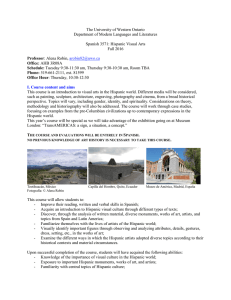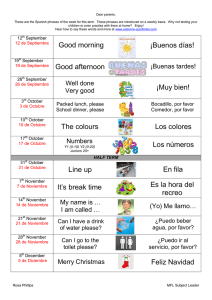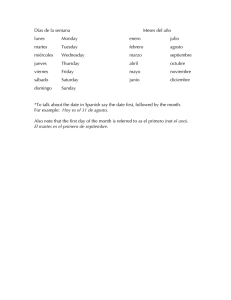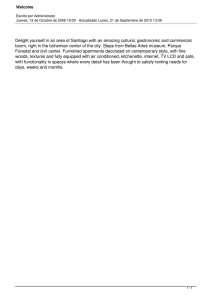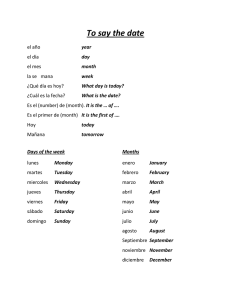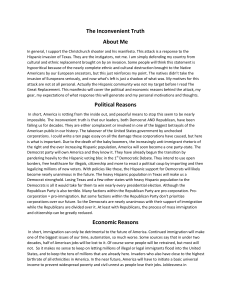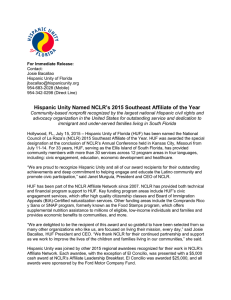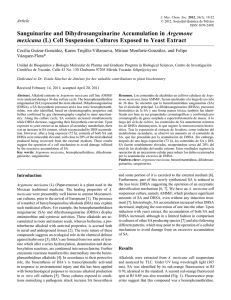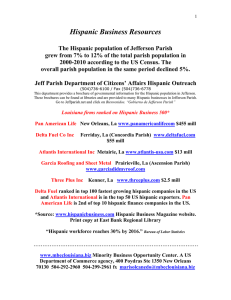The University of Western Ontario Department of Modern
Anuncio
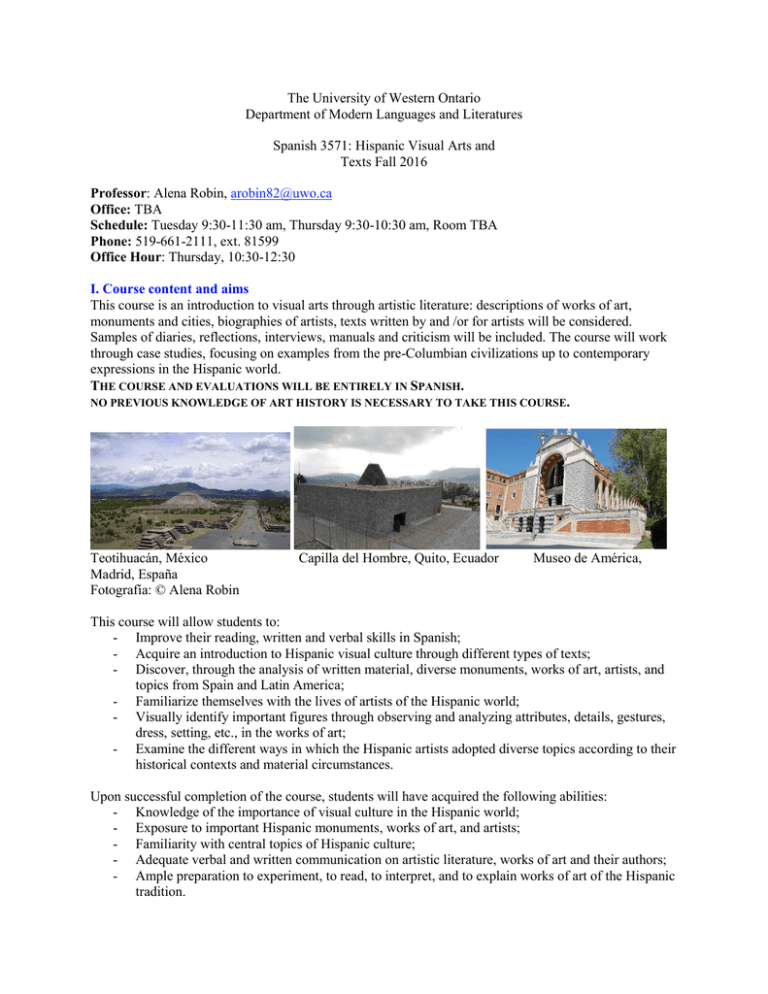
The University of Western Ontario Department of Modern Languages and Literatures Spanish 3571: Hispanic Visual Arts and Texts Fall 2016 Professor: Alena Robin, arobin82@uwo.ca Office: TBA Schedule: Tuesday 9:30-11:30 am, Thursday 9:30-10:30 am, Room TBA Phone: 519-661-2111, ext. 81599 Office Hour: Thursday, 10:30-12:30 I. Course content and aims This course is an introduction to visual arts through artistic literature: descriptions of works of art, monuments and cities, biographies of artists, texts written by and /or for artists will be considered. Samples of diaries, reflections, interviews, manuals and criticism will be included. The course will work through case studies, focusing on examples from the pre-Columbian civilizations up to contemporary expressions in the Hispanic world. THE COURSE AND EVALUATIONS WILL BE ENTIRELY IN SPANISH. NO PREVIOUS KNOWLEDGE OF ART HISTORY IS NECESSARY TO TAKE THIS COURSE. Teotihuacán, México Madrid, España Fotografía: © Alena Robin Capilla del Hombre, Quito, Ecuador Museo de América, This course will allow students to: - Improve their reading, written and verbal skills in Spanish; - Acquire an introduction to Hispanic visual culture through different types of texts; - Discover, through the analysis of written material, diverse monuments, works of art, artists, and topics from Spain and Latin America; - Familiarize themselves with the lives of artists of the Hispanic world; - Visually identify important figures through observing and analyzing attributes, details, gestures, dress, setting, etc., in the works of art; - Examine the different ways in which the Hispanic artists adopted diverse topics according to their historical contexts and material circumstances. Upon successful completion of the course, students will have acquired the following abilities: - Knowledge of the importance of visual culture in the Hispanic world; - Exposure to important Hispanic monuments, works of art, and artists; - Familiarity with central topics of Hispanic culture; - Adequate verbal and written communication on artistic literature, works of art and their authors; - Ample preparation to experiment, to read, to interpret, and to explain works of art of the Hispanic tradition. II. Prerequisites Prerequisite(s): Spanish 2200, 2200W/X or permission of the Department. Pre-or Corequisite(s): Spanish 2215F/G, 2216F/G or 2800F/G. III. Evaluation Participation (10%): Students are expected to attend every class unless medical circumstances prevent them from doing so (please see section below on department policies). The success of the course depends on the frequency and quality of the participation of its members. Assigned readings should be done prior to class in order to be adequately discussed in class. Students are expected to come prepared with ideas for discussion. Being present in class does not necessarily imply participating in it. Similarly, being absent from class on a repetitive basis will seriously affect the participation mark. When absent, it is still the student’s responsibility to complete and turn in coursework on time and catch up on the material covered in class. Students must inform their professor by email of any absence as soon as possible. Surprise quizzes (10%): To regularly control the acquisition of new knowledge, various short surprise quizzes will be administered throughout the semester, at the beginning of class. One more reason to attend class on a regular basis and be punctual! Short written assignment (5%): What is your experience with Hispanic visual art? Have you travelled to any Spanish speaking country, visited any museum, church, archeological site related to the Hispanic tradition? Do you have a favorite Hispanic artist? Are you an artist yourself? Tell me about yourself in relation to arts in 500 words! Due September 15. Oral presentation (15%) and written report (around 500 words) with bibliography (5%): In small groups (to be determined the first week of class) students will do one oral presentation (20 minutes each presentation). Students are responsible for preparing a fictitious fieldtrip to an archaeological site of the Hispanic world. Be creative! Some information to be provided: where the site is located, the population that used to live there, when the site was discovered and by whom, describe some important buildings and works encountered at the site, describe the different phases of excavation, etc.: October 4 and 6. The presentation calendar will be adjusted according to the size of the group. PLEASE NOTE: For group activities, the same grade will be given to all members of a group. Creative Assignment (10%): In relation to the tradition of exvotos that we will be covered in class (October 20th), create your own! Think of a reason/ event to be grateful for. Explain in your own words what you are grateful for, to whom and illustrate this. Be creative! No need to be an artist! Due November 1st. Final project in two parts: due October 20th (10%) and December 6th (35%). The final project is to be done on an individual basis. The final essay will take the form of a small exhibit catalogue. The subject for the exhibition is open, but must be related to the course: visual art of the Hispanic world, of material not covered in class. Further information will be provided in class. IMPORTANT: The only acceptable reason for turning in a late assignment or missing an examination is for medical purposes (see section on Absenteeism below). Late assignments will lose 5 points per day (out of 100%). Assignments turned in a week after the due date (7 days) will not be accepted and will receive a grade of “0.” All university regulations concerning plagiarism apply. If you are unsure about plagiarism, please ask. The Department of Modern Languages and Literatures Policies which govern the conduct, standards, and expectations for student participation in Modern Languages and Literatures courses is available in the Undergraduate section of the Department of Modern Languages and Literatures website at http://www.uwo.ca/modlang/undergraduate/policies.html. It is your responsibility to understand the policies set out by the Senate and the Department of Modern Languages and Literatures, and thus ignorance of these policies cannot be used as grounds of appeal. Electronic Devices: You are encouraged to bring tablets and laptops to class, as we may use them for some in-class activities. However, I expect you to avoid using cellphones in class and only use your laptop, tablet, or other technologies for note taking and in-class activities. IV. Mandatory readings and calendar of activities All readings will be available through the OWL site of the course. FECHA Y TEMA LECTURA/ ACTIVIDAD Jueves 8 de septiembre Introducción Presentación del curso Martes 13 de septiembre 1. Interrogating the Work of Art J 15 de septiembre El mundo prehispánico: Los códices Readings: 2. Joaquín Galarza, “Los códices mexicanos”, Arqueología mexicana, 1997, vol. IV, núm. 23, pp. 6-13. 3. “Códices prehispánicos y coloniales tempranos”, Arqueología mexicana, 2009, núm. 31, p. 9. First written assignment due M 20 de septiembre La tira de peregrinación Reading: 4. Patrick Johansson, “Tira de peregrinación (Códice Boturini)”, Arqueología mexicana, 2009, núm. 31, pp. 56-57. J 22 de septiembre La ciudad de MéxicoTenochtitlan Readings: 5. Bertina Olmedo Vera, “Tenochtitlan en números”, Arqueología mexicana, 1993, vol. 1, núm. 4, p. 65. 6. Hernán Cortés, “Segunda carta-relación” (30 de octubre 1520), Cartas de relación, Madrid, Historia 16, 1985, pp. 131-141. 7. Bernal Díaz del Castillo, Historia verdadera de la conquista de la Nueva España, México, Porrúa, 2002 [1632], pp. 171-177. M 27 de septiembre El templo Mayor Reading: http://www.templomayor.inah.gob.mx/index.php J 29 de septiembre Sesión informativa en la biblioteca Weldon Library's instruction room M 4 de octubre Presentación Oral I J 6 de octubre Presentación Oral I M 11 de octubre Arquitectura de la evangelización Reading: 8. TBA J 13 de octubre Pintura mural del siglo XVI Reading: 9. TBA M 18 de octubre Imágenes milagrosas, santuarios y lugares de peregrinación Reading: 10. TBA J 20 de octubre Exvotos Reading: 11. TBA Proposal for final project is due M 25 de octubre La ciudad colonial Readings: 12. Bernardo de Balbuena, La grandeza mexicana, México, Porrúa, 2001 [1604], pp. 59-67. J 27 de octubre No class: Fall Study Break M 1 de noviembre Diego Rivera (1886-1957) Reading: 13. Francisco González Rul, “Diego Rivera y la arqueología mexicana. La raíz profunda”, Arqueología mexicana, Edición especial, núm. 47, 2012, pp. 84-87. Creative assignment is due J 3 de noviembre Remedios Varo (1908-1963) Invited speaker: Aya Ishai Reading: 14. Remedios Varo, “Trigo, aceitunas y naranjas. Presérvate del frío con lana de oveja”, en “A veces escribo como si trazase un boceto”. Los escritos de Remedios Varo, ed. Edith Mendoza Bolio, Madrid/ Frankfurt/ México, Iberoamericana/ Vervuet/ Bonilla Artigas Editores, pp. 223225. M 8 de noviembre Frida Kahlo (1907-1954) Movie screened in class: Frida, 2002, Julie Taymor, director, 123 min. J 10 de noviembre Discussion of movie M 15 de noviembre Nahui Olin (1893-1978) Reading: 15. Elena Poniatowska, Las siete cabritas, 2001, pp. 59-84. J 17 de noviembre María Izquierdo (1902-1955) Reading: 16. Elena Poniatowska, Las siete cabritas, 2001, pp. 85-108. M 22 de noviembre Fernando Botero (1932- ) Reading: “Fernando Botero y Abu Ghraib: No pude quedar callado”, Revolución, núm. 79, 25 de febrero de 2007: http://revcom.us/a/079/botero-es.html J 24 de noviembre El Museo Nacional de la Muerte 17. Alena Robin, “El Museo nacional de la Muerte,” UIC. Foro multidisciplinario de la Universidad Intercontinental, 7, 2008, pp. 4853. M 29 de noviembre Oswaldo Guayasamin (19191999) Reading: http://www.guayasamin.org http://www.capilladelhombre.com/ J 1 de diciembre Museos de arte hispano en Nueva York M 6 de diciembre Conclusión del curso Final project is due
